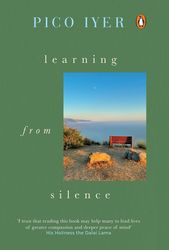Someone once said that it is only in solitude that one can hear the mystic notes of the universe. Writer Pico Iyer would agree. After all, he has been courting silence for close to 34 years. Ironically, it is the chaos of a wildfire that first draws him to the calm of a monastery. It is while he is sleeping on the floor of someone’s house, after a wildfire destroys his, that a friend suggests he visit a Catholic monastery in Big Sur, California. What has he to lose, he thinks. He gets into his dusty white Plymouth Horizon and follows the interstate freeway, into the inky darkness of the unknown.
Once there, a monk guides him to his room, with a single bed on one side, a rocking chair next to the blond-wood dresser. Through the windows, “the ocean a sheet of fire”. And a wide expanse of silence, waiting to be tilled and tamed.
“Why am I exultant to find myself in the silence of this Catholic monastery?” he writes in his recent book, Learning from Silence. “Maybe because there is no “I” to get in the way of the exultancy. Only the brightness of the blue above and below. That red-tailed hawk circling, the bees busy in the lavender. It’s as if a lens cap has come off and once the self is gone, the world can come flooding in, in all its wild immediacy.”
❖❖❖
There are distant echoes of those who have gone before him in this lone, but never lonely, pilgrimage. Those like Admiral Richard Byrd who spent five months alone in a shack near the South Pole. “In his little cell,” writes Iyer, “he came to see that success might be another word for peace and peace, at heart, for freedom from ceaseless striving. Though close at times to death, he ‘felt more alive’, he confesses, in his solitude, ‘than at any other time in my life’.”
Or the Dalai Lama, with whom Iyer travelled for 10 years across Japan. “I noticed that I grew exhausted just watching him go through his days, even though I am 22 years younger,” Iyer told THE WEEK. “In time, I realised this was because, every morning, while I was enjoying my beauty sleep and tucking into a large buffet in the breakfast room, he was engaging in four hours of meditation―to gather his resources and strength so as to have most to give to everyone he met during his eight-hour working day.”
But the ones whose silence is most deafening are the monks of the monastery themselves, with a kind of unwavering, iron-clad joy. “I have been here eight months now and still I feel I’m on honeymoon,” one of them tells Iyer. “Every morning I wake up and touch my forehead to the ground. Can this last?”
While silence is a full-stop for the monks, for Iyer, it is a comma―an expunging of the world before returning to it.
❖❖❖
The book is written in the form of dream-like vignettes soaked in whimsy and wisdom. It is almost like Iyer is describing another world far removed from our pressure-cooker one―held together by a silent magnetic field in which more is said by what is left unsaid.

For a travel writer like Iyer―who has published 15 books translated into 23 languages, “on subjects ranging from the Dalai Lama to globalism, from the Cuban revolution to Islamic mysticism”―this is travel of a different kind, a sojourn to the inner from the outer, a kind of deep-sea excavation of the mind.
“The travel is interesting,” he writes. “It keeps me in touch with the lives of others. The relief comes in getting to be oneself.”
❖❖❖
Iyer’s rendezvous with silence began years ago, even before he discovered the monastery. He is an only child and having studied at a boarding school since the age of nine, he grew up six thousand miles from the nearest relative. “From an early age I loved being by myself and never got bored or ran out of excitement so long as I was left to my own devices,” he says.
An uncle remembers seeing him in Oxford at the age of three, surrounded by the toy cars he was arranging into patterns all around him, completely self-sufficient and delighted. “I’m not sure I have changed or evolved much since then,” he says. He partly chose to be a writer because it involves sitting alone at one’s desk for hours every day. And he sometimes took to the road because that allowed him to spend all day by himself, “in intimate, unbroken conversation with the world”.
Through it all, the silence has been a bulwark against the blows. It has stood him through the loss of a home, a father’s death, a daughter’s cancer diagnosis, a mother’s illness…. It has ordered a discordant mind, teased music from the cacophony of grief.
❖❖❖
And now, all these years later, Iyer hardly recognises the person who first came to the monastery, four days after his 34th birthday, so fresh and open. “Yet, the sentences I write, on every visit, are exactly the same cries of affirmation and joy that he once penned….,” he writes. “The views through the windows still put my passing hopes and ideas, my anxious thoughts in place.”
To find something you can’t doubt, realises Iyer, may be the closest that some of us need to get to faith.
LEARNING FROM SILENCE
By Pico Iyer
Published by Penguin Random House India
Price Rs599; pages 210


